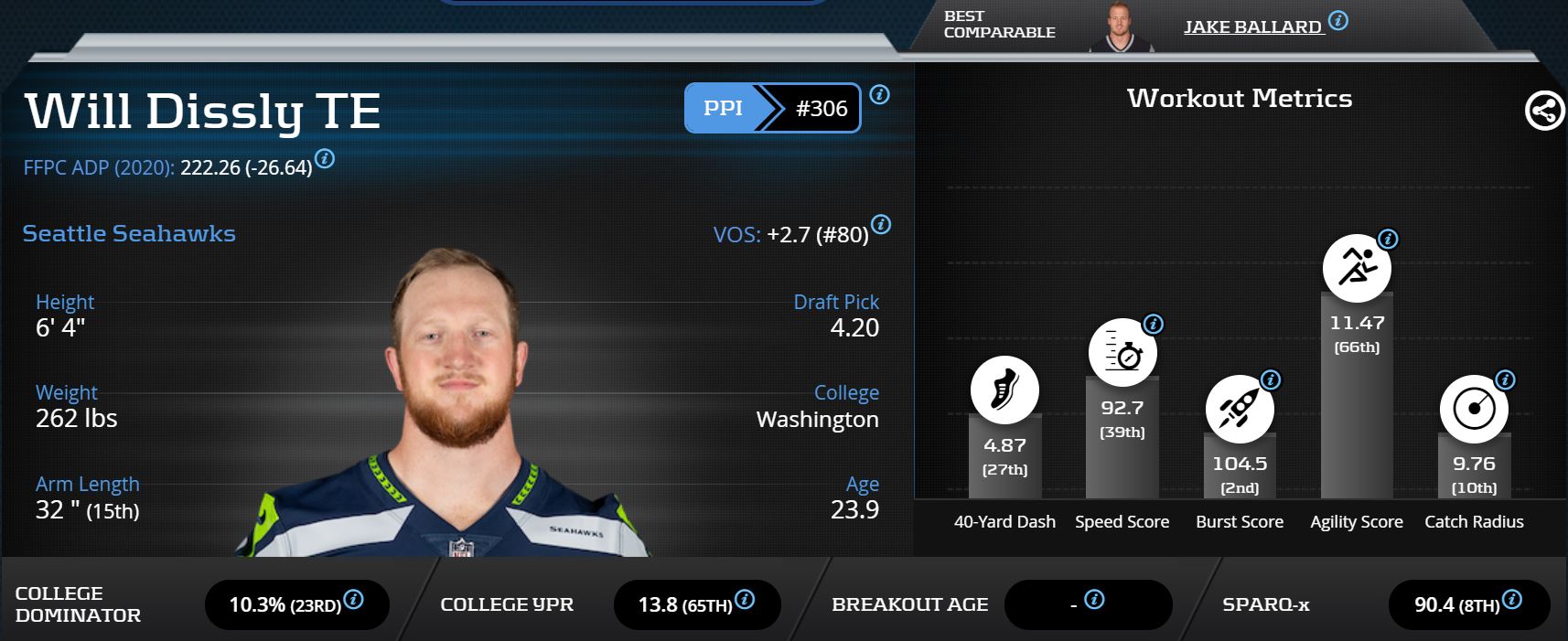There are many high-upside, late round tight ends primed to experience fantasy football breakouts this season. With an overwhelming amount of options, we can’t forget about the strongest late round breakout candidate of all. PlayerProfiler’s advanced stats and metrics point to Will Dissly as this year’s late round smash play.
At 6-4, 262-pounds with a 11.47 (66th-percentile among qualified tight ends) Agility Score, Dissly fits the athletic mold required to be considered a high-upside tight end. He has fourth-round draft capital and averaged 13.8 (65th-percentile) college yards per reception. His 60.1-percent (No. 37) Snap Share was similar to Jared Cook’s 55.1-percent (No. 41), Irv Smith‘s 61.7-percent (No. 34), and Tyler Higbee’s 66.6-percent (No. 27) marks. All of those players have significantly higher ADPs than Dissly, whose 3.8 (No. 14) receptions per game put him just above current teammate Greg Olsen and just below Dallas Goedert.
Check out Will Dissly’s 2020 Projection on PlayerProfiler’s “World Famous” Draft Kit:
Dissly’s current ADP put him outside the top 200 players in both redraft and dynasty. His most valuable quality by far is his red zone production. In 2019, he had a 19.4-percent Red Zone Target Share with four red zone receptions and a 100-percent Contested Catch Rate in six games played. Other notable season-long stats he accrued include a 22.0-percent (No. 10) Dominator Rating, four (No 14) total touchdowns, and 188 (No. 31) Completed Air Yards. All in less than half a season. Not to mention the best part of his player profile, he is only turning 24 years old.
Situation
Will Dissly has the production and player profile that fantasy gamers love in their tight ends. That’s before considering his situation. Dissly currently stands as the No. 3 target in a Russell Wilson-led offense with two years of rapport with both Wilson and the coaching staff. D.K. Metcalf and Tyler Lockett form a nice 1A-1B tandem at receiver with a combined 13.1 targets per game in 2019; but Wilson averaged 32.2 passes per game in 2019 and put up 31 (No. 3) passing touchdowns. There is plenty of meat on the bone for a third and even a fourth contributor in this passing game. These are Dissly’s biggest competitors to be that third option.
Greg Olsen
Greg Olsen is a 35-year old tight end with a significant injury history who is now changing teams. Will Dissly is far more productive than Olsen at this point of their careers. The numbers from 2019 back this up. The two had similar Target Shares both overall and in the red zone. Olsen had a significantly higher Snap Share, with more team pass plays and targets per game.
Despite the disadvantage in terms of volume, Dissly blew Olsen out of the water in terms of Touchdown Rate and True Catch Rate. The difference in their volume more than makes up for the larger number of uncatchable targets thrown to Olsen. The high Snap Share coupled with Olsen’s red zone target share shows that he is no longer a strong option in that area of the field. At most, he will be on the field often to block in a run-first Seattle offense and will steal targets and yards between the 20’s. None of that will matter when Dissly racks up double digit touchdowns.
Jacob Hollister
Jacob Hollister showed that he has talent during his stretch as the starter for Seattle in 2019. He commanded a 74.6-percent (No. 17) Snap Share, an 18.9-percent (No. 7) Target Share, 5.9 (No. 11) targets per game, seven (No. 11) red zone receptions, and a 7.3-percent Touchdown Rate. His red zone work was less than half that of Will Dissly, but his 141 (No. 10) yards after the catch in ten games was admirable.
Hollister offers upside for Seattle as a backup, but if Dissly and Greg Olsen are healthy, he is just a backup with a rotational role at best. He’s an undersized, undrafted 26-year old tight end with his best games coming during a stretch where Dissly and Tyler Lockett were hurt and the only better option on the team was an ascending rookie with a limited route tree. Hollister also has a history of soft tissue injuries with a chest strain in 2017 and a hamstring strain in 2018, bringing his conditioning into question. His presence does not provide any threat to Dissly’s upside.
The Running Backs
There’s no reason to believe any back currently employed by the Seattle Seahawks will push for significant targets, hindering a third option from emerging on this team. Taking a look at the 2019 receiving stats for the three currently rostered shows nothing to be worried about.
These guys will have their roles and Seattle has a history of a run-first approaches. In terms of the passing game and red zone passing production though, they are a non factor. Carlos Hyde is new in town and likely a backup. Rashaad Penny will start the year on the PUP. Chris Carson has been admirable when called upon, but has not racked up the type of numbers to be a significant threat to the production of the primary passing options on this team.
Injury Risk
Now the elephant in the room is Will Dissly’s injury history; which has prevented him from completing even a half season. His ADP is being falsely suppressed due to an injury prone label, but his two injuries these past seasons are more aligned with the side of freak injury than structural problem. He had a patellar tendon rupture in 2018, but he recovered from it and played fine in 2019. Then he suffered an Achilles tendon tear in Week 6 of 2019. This injury has a 6-9 month recovery window. He’s expected to be ready for the offseason and the two injuries are unrelated.
Dissly’s injury risk is real, but it is also baked into his ADP. He is essentially free in all formats. He can be picked as a team’s third tight end in the late teens and even after round 20 in all formats. His ceiling is top 12 tight end in 2020, with the opportunity to be the primary red zone weapon and touchdown scorer for Russell Wilson. In FFPC high stakes drafts, he is being picked on average 50 spots after Greg Olsen, who is well beyond the age apex and mostly a locker room presence at this point in his career with a TV contract already lined up when he does retire. Dissly did not injure an ankle or ACL. Considering he is free in all formats, we should be more than willing to swallow that injury pill for a potential top 12 tight end producer.
Conclusion
Seattle has no third receiver of consequence, with their depth including Phillip Dorsett, David Moore, and potentially Josh Gordon if rumors hold serve. The tight end room has solid depth, but no true competition for red zone targets. Will Dissly has a proven track record of dominating at the tight end position in both real and fantasy football. His injury prone label has pushed him outside the top 200 players in all formats. Smash the draft button every time for Dissly late in 2020 drafts.







